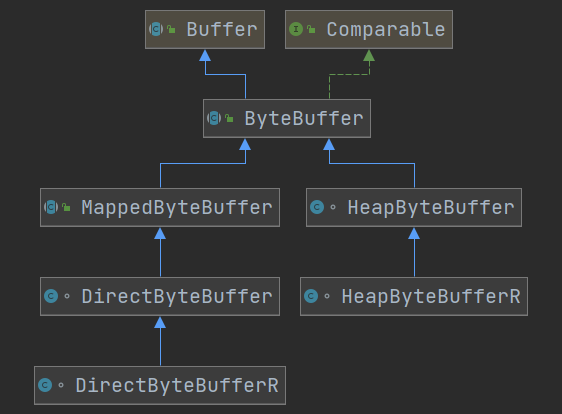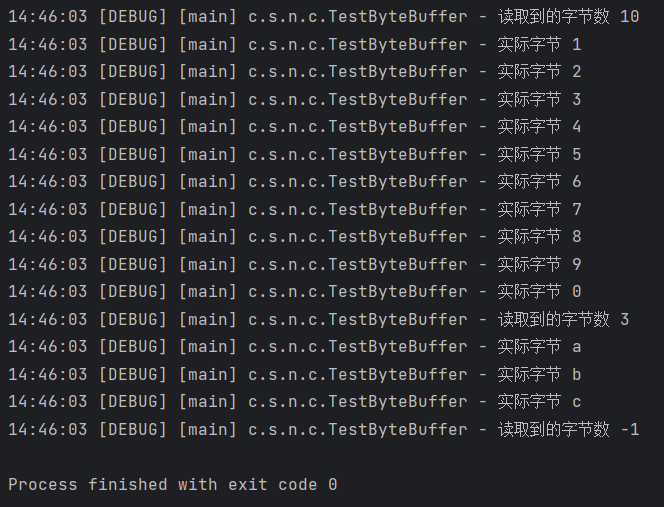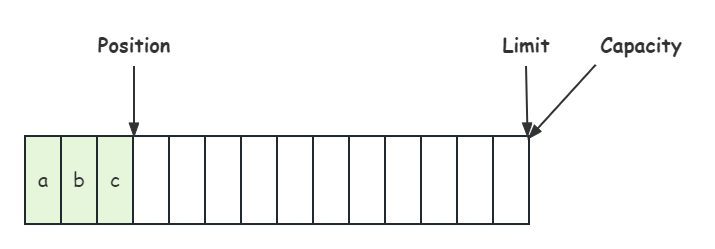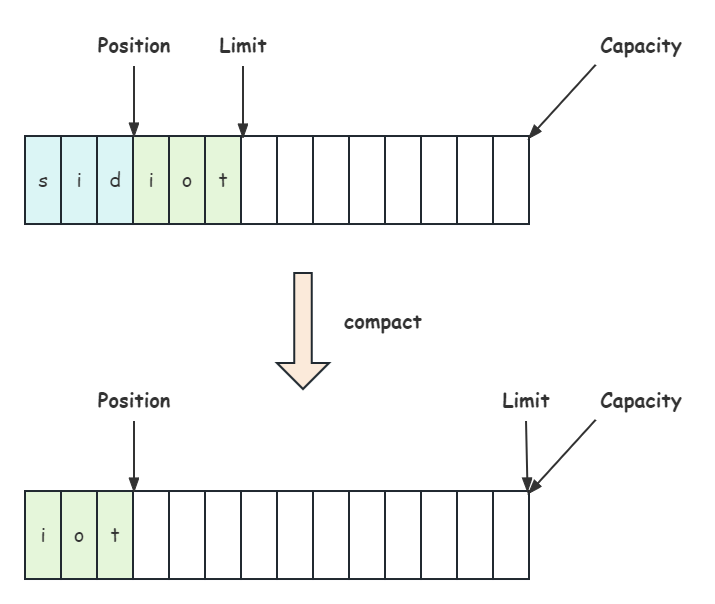前言
本篇博文是《从 0 到 1 学习 Netty》中 NIO 系列的第一篇博文,主要内容是介绍 NIO 的核心之一 Buffer 中的 ByteBuffer,往期系列文章请访问博主的 Netty 专栏,博文中的所有代码全部收集在博主的 GitHub 仓库中;
什么是 Netty?
Netty 是一个高性能、异步事件驱动的网络应用程序框架,主要用于快速开发可维护、可扩展的高性能服务器和客户端。Netty 提供了简单易用的 API,支持多种协议和传输方式,并且有着高度灵活的扩展和自定义能力。
Netty 的设计目标是提供一种易于使用、高效、可扩展的异步 IO 网络编程框架。它采用了 NIO(Non-blocking IO)的方式来进行网络操作,避免了传统的阻塞式 IO 常常面临的性能瓶颈。同时,Netty 还提供了优秀的线程模型和内存管理机制,保证了高并发下的稳定性和性能。
通过 Netty,开发者可以方便地实现基于 TCP、UDP、HTTP、WebSocket 等多种协议的通信应用。同时,Netty 还提供了编解码器、SSL 支持等组件,使得开发者可以更加专注于业务逻辑的实现。
什么是 ByteBuffer?
ByteBuffer 是 Java 中的一个类,它提供了一种方便的方式来处理原始字节数据。ByteBuffer 可以被看作是一个缓冲区,它可以容纳一定数量的字节数据,并提供了一系列方法来操作这些数据。
使用 ByteBuffer,可以轻松地读取和写入二进制数据。它还提供了对不同类型数据的支持,如整数、浮点数等。ByteBuffer 还支持对数据进行切片,以及对缓冲区中的数据进行复制、压缩、解压等操作。
在 Java 中,ByteBuffer 通常用于处理 I/O 操作,例如从文件或网络中读取和写入数据。它也可以用于处理加密和解密数据,以及处理图像和音频文件等二进制数据。总之,ByteBuffer 是 Java 中非常有用的一个类,可以帮助开发人员更轻松地处理二进制数据。
基本使用
向 buffer 写入数据,例如调用 channel.read(buffer);
调用 flip() 切换至读模式
flip 会使得 buffer 中的 limit 变为 position,position 变为 0
从 buffer 读取数据,例如调用 buffer.get();
调用 clear() 或者 compact() 切换至写模式
调用 clear() 方法时,position=0,limit 变为 capacity;
调用 compact() 方法时,会将缓冲区中的未读数据压缩到缓冲区前面;
重复 1~4 的步骤;
编写代码进行测试:
@Slf4jpublic class TestByteBuffer {
public static void main(String[] args) {
try (FileChannel channel = new FileInputStream("data.txt").getChannel()) { // 准备缓冲区 ByteBuffer buffer = ByteBuffer.allocate(10); while (true) { // 从 channel 读取数据写入到 buffer int len = channel.read(buffer); log.debug("读取到的字节数 {}", len); if (len == -1) break;
// 打印 buffer 内容 buffer.flip(); // 切换至读模式 while(buffer.hasRemaining()) { // 是否还有剩余未读数据 byte b = buffer.get(); log.debug("实际字节 {}", (char)b); } buffer.clear(); } } catch (IOException e) {
}
}
}
复制代码
运行结果:
注意,日志需要进行配置,在 /src/main/resources/ 路径下,创建 logback.xml,由于篇幅原因,自行在我的 GitHub 上下载:logback.xml;
将末尾部分的 <logger name="com.sidiot.netty" level="DEBUG" additivity="false"> 中的 name 的属性值改成自己的包名即可。
部分读者可能会遇到如下问题:
这是由于 lombok 引起的,需要检查一下是否安装了 lombok 的插件,以及是否是最新版的 lombok,博主这里用的版本如下:
<dependency> <groupId>org.projectlombok</groupId> <artifactId>lombok</artifactId> <version>1.18.26</version> </dependency>
复制代码
内部结构
字节缓冲区的父类 Buffer 中有四个核心属性,从以下源码中可以清晰获知:
// Invariants: mark <= position <= limit <= capacity private int mark = -1; private int position = 0; private int limit; private int capacity;
复制代码
position:表示当前缓冲区中下一个要被读或写的字节索引位置,默认值为 0。当我们调用 put() 方法往缓冲区中写入数据时,position 会自动向后移动,指向下一个可写的位置;当我们调用 get() 方法从缓冲区中读取数据时,position 也会自动向后移动,指向下一个可读的位置。
limit:表示当前缓冲区的限制大小,默认值为 capacity。在写模式下,limit 表示缓冲区最多能够写入的字节数;在读模式下,limit 表示缓冲区最多能够读取的字节数。在一些场景下,我们可以通过设置 limit 来防止越界访问缓冲区。
capacity:表示缓冲区的容量大小,默认创建 Buffer 对象时指定。capacity 只能在创建缓冲区时指定,并且不能改变。例如,我们可以创建一个容量为 1024 字节的 Buffer 对象,然后往里面写入不超过 1024 字节的数据。
mark:mark 和 reset 方法一起使用,用于记录和恢复 position 的值。在 ByteBuffer 中,我们可以通过调用 mark() 方法来记录当前 position 的值,然后随意移动 position,最后再通过调用 reset() 方法将 position 恢复到 mark 记录的位置。使用 mark 和 reset 可以在某些情况下提高代码的效率,避免频繁地重新计算或查询某个值。
这些属性一起组成了 Buffer 的状态,我们可以根据它们的值来确定当前缓冲区的状态和可操作范围。
初始化时,position,limit,capacity 的位置如下:
写模式下,position 代表写入位置,limit 代表写入容量,写入 3 个字节后的状态如下图所示:
当使用 flip() 函数切换至读模式后,position 切换为读取位置,limit 切换为读取限制:
这个变换也可以从 flip() 的源码清晰的获知:
public Buffer flip() { limit = position; position = 0; mark = -1; return this;}
复制代码
当读完之后,使用 clean() 函数清空缓存区,可从源码获知,缓冲区又变成了初始化时的状态:
public Buffer clear() { position = 0; limit = capacity; mark = -1; return this;}
复制代码
这里还有一种方法 compact(),其作用是将未读完的部分向前压缩,然后切换至写模式,不过需要注意的是,这是 ByteBuffer 中的方法:
接下来,将要结合代码对上述内容进行深入理解;
这里用到了一个自定义的工具类 ByteBufferUtil,由于篇幅原因,自行从我的 Github 上进行获取: ByteBufferUtil.java;
编写一个测试类,对 ByteBuffer 的常用方法进行测试:
public class TestByteBufferReadWrite { public static void main(String[] args) { ByteBuffer buffer = ByteBuffer.allocate(10);
// 写入一个字节的数据 buffer.put((byte) 0x73); debugAll(buffer);
// 写入一组五个字节的数据 buffer.put(new byte[]{0x69, 0x64, 0x69, 0x6f, 0x74}); debugAll(buffer);
// 获取数据 buffer.flip(); ByteBufferUtil.debugAll(buffer); System.out.println((char) buffer.get()); System.out.println((char) buffer.get()); ByteBufferUtil.debugAll(buffer);
// 使用 compact 切换写模式 buffer.compact(); ByteBufferUtil.debugAll(buffer);
// 再次写入 buffer.put((byte) 102); buffer.put((byte) 103); ByteBufferUtil.debugAll(buffer); }}
复制代码
运行结果:
// 向缓冲区写入了一个字节的数据,此时 postition 为 1;+--------+-------------------- all ------------------------+----------------+position: [1], limit: [10] +-------------------------------------------------+ | 0 1 2 3 4 5 6 7 8 9 a b c d e f |+--------+-------------------------------------------------+----------------+|00000000| 73 00 00 00 00 00 00 00 00 00 |s......... |+--------+-------------------------------------------------+----------------+
// 向缓冲区写入了五个字节的数据,此时 postition 为 6;+--------+-------------------- all ------------------------+----------------+position: [6], limit: [10] +-------------------------------------------------+ | 0 1 2 3 4 5 6 7 8 9 a b c d e f |+--------+-------------------------------------------------+----------------+|00000000| 73 69 64 69 6f 74 00 00 00 00 |sidiot.... |+--------+-------------------------------------------------+----------------+
// 调用 flip() 切换至读模式,此时 position 为 0,表示从第 0 个数据开始读取;// 同时要注意,此时的 limit 为 6,表示 position=6 时内容就读完了;+--------+-------------------- all ------------------------+----------------+position: [0], limit: [6] +-------------------------------------------------+ | 0 1 2 3 4 5 6 7 8 9 a b c d e f |+--------+-------------------------------------------------+----------------+|00000000| 73 69 64 69 6f 74 00 00 00 00 |sidiot.... |+--------+-------------------------------------------------+----------------+
// 读取两个字节的数据;si
// 此时 position 变为 2; +--------+-------------------- all ------------------------+----------------+position: [2], limit: [6] +-------------------------------------------------+ | 0 1 2 3 4 5 6 7 8 9 a b c d e f |+--------+-------------------------------------------------+----------------+|00000000| 73 69 64 69 6f 74 00 00 00 00 |sidiot.... |+--------+-------------------------------------------------+----------------+
// 调用 compact() 切换至写模式,此时 position 及其后面的数据被压缩到 ByteBuffer 的前面;// 此时 position 为 4,会覆盖之前的数据; +--------+-------------------- all ------------------------+----------------+position: [4], limit: [10] +-------------------------------------------------+ | 0 1 2 3 4 5 6 7 8 9 a b c d e f |+--------+-------------------------------------------------+----------------+|00000000| 64 69 6f 74 6f 74 00 00 00 00 |diotot.... |+--------+-------------------------------------------------+----------------+
// 再次写入两个字节的数据,之前的 0x6f 0x74 被覆盖; +--------+-------------------- all ------------------------+----------------+position: [6], limit: [10] +-------------------------------------------------+ | 0 1 2 3 4 5 6 7 8 9 a b c d e f |+--------+-------------------------------------------------+----------------+|00000000| 64 69 6f 74 66 67 00 00 00 00 |diotfg.... |+--------+-------------------------------------------------+----------------+
Process finished with exit code 0
复制代码
空间分配
在上述内容中,我们使用 allocate() 方法来为 ByteBuffer 分配空间,当然还有其他方法也可以为 ByteBuffer 分配空间;
public class TestByteBufferAllocate { public static void main(String[] args) {
System.out.println(ByteBuffer.allocate(16).getClass()); System.out.println(ByteBuffer.allocateDirect(16).getClass()); /* class java.nio.HeapByteBuffer - java 堆内存, 读写效率低, 受垃圾回收 GC 的影响; class java.nio.DirectByteBuffer - 直接内存,读写效率高(少一次拷贝),不会受 GC 的影响; - 使用完后 需要彻底的释放,以免内存泄露; */
}}
复制代码
写入数据
读取数据
rewind
public Buffer rewind() { position = 0; mark = -1; return this;}
复制代码
rewind() 的作用是将 position 设置为 0,这意味着下一次读取或写入操作将从缓冲区的开头开始。
@Testpublic void testRewind() { // rewind 从头开始读 ByteBuffer buffer = ByteBuffer.allocate(16); buffer.put(new byte[]{'s', 'i', 'd', 'i', 'o', 't'}); buffer.flip(); buffer.get(new byte[6]); debugAll(buffer); buffer.rewind(); System.out.println((char) buffer.get());}
复制代码
运行结果:
+--------+-------------------- all ------------------------+----------------+position: [6], limit: [6] +-------------------------------------------------+ | 0 1 2 3 4 5 6 7 8 9 a b c d e f |+--------+-------------------------------------------------+----------------+|00000000| 73 69 64 69 6f 74 00 00 00 00 00 00 00 00 00 00 |sidiot..........|+--------+-------------------------------------------------+----------------+
// 从头读到第一个字符 's';s
Process finished with exit code 0
复制代码
mark 和 reset
public Buffer mark() { mark = position; return this;}
复制代码
mark() 用于在缓冲区中设置标记;
public Buffer reset() { int m = mark; if (m < 0) throw new InvalidMarkException(); position = m; return this;}
复制代码
reset() 用于返回到标记位置;
@Testpublic void testMarkAndReset() { // mark 做一个标记,用于记录 position 的位置;reset 是将 position 重置到 mark 的位置; ByteBuffer buffer = ByteBuffer.allocate(16); buffer.put(new byte[]{'s', 'i', 'd', 'i', 'o', 't'}); buffer.flip(); System.out.println((char) buffer.get()); System.out.println((char) buffer.get()); buffer.mark(); // 添加标记为索引2的位置; System.out.println((char) buffer.get()); System.out.println((char) buffer.get()); debugAll(buffer); buffer.reset(); // 将 position 重置到索引2; debugAll(buffer); System.out.println((char) buffer.get()); System.out.println((char) buffer.get());}
复制代码
运行结果:
sidi
+--------+-------------------- all ------------------------+----------------+position: [4], limit: [6] +-------------------------------------------------+ | 0 1 2 3 4 5 6 7 8 9 a b c d e f |+--------+-------------------------------------------------+----------------+|00000000| 73 69 64 69 6f 74 00 00 00 00 00 00 00 00 00 00 |sidiot..........|+--------+-------------------------------------------------+----------------+
// position 从4重置为2;+--------+-------------------- all ------------------------+----------------+position: [2], limit: [6] +-------------------------------------------------+ | 0 1 2 3 4 5 6 7 8 9 a b c d e f |+--------+-------------------------------------------------+----------------+|00000000| 73 69 64 69 6f 74 00 00 00 00 00 00 00 00 00 00 |sidiot..........|+--------+-------------------------------------------------+----------------+
di
Process finished with exit code 0
复制代码
get(i)
get(i) 不会改变读索引的位置;
@Testpublic void testGet_i() { // get(i) 不会改变读索引的位置; ByteBuffer buffer = ByteBuffer.allocate(16); buffer.put(new byte[]{'s', 'i', 'd', 'i', 'o', 't'}); buffer.flip(); System.out.println((char) buffer.get(2)); debugAll(buffer);}
复制代码
运行结果:
d+--------+-------------------- all ------------------------+----------------+position: [0], limit: [6] +-------------------------------------------------+ | 0 1 2 3 4 5 6 7 8 9 a b c d e f |+--------+-------------------------------------------------+----------------+|00000000| 73 69 64 69 6f 74 00 00 00 00 00 00 00 00 00 00 |sidiot..........|+--------+-------------------------------------------------+----------------+
Process finished with exit code 0
复制代码
字符串与 ByteBuffer 的相互转换
getBytes
public byte[] getBytes() { return StringCoding.encode(coder(), value);}
复制代码
字符串调用 getByte() 方法获得 byte 数组,将 byte 数组放入 ByteBuffer 中:
@Testpublic void testGetBytes() { ByteBuffer buffer = ByteBuffer.allocate(16); buffer.put("sidiot".getBytes()); debugAll(buffer);}
复制代码
运行结果:
+--------+-------------------- all ------------------------+----------------+position: [6], limit: [16] +-------------------------------------------------+ | 0 1 2 3 4 5 6 7 8 9 a b c d e f |+--------+-------------------------------------------------+----------------+|00000000| 73 69 64 69 6f 74 00 00 00 00 00 00 00 00 00 00 |sidiot..........|+--------+-------------------------------------------------+----------------+
Process finished with exit code 0
复制代码
charset
public final ByteBuffer encode(String str) { return encode(CharBuffer.wrap(str));}
复制代码
通过 StandardCharsets 的 encode() 方法获得 ByteBuffer,此时获得的 ByteBuffer 为读模式,无需通过 flip() 切换模式:
@Testpublic void testCharset() { ByteBuffer buffer = StandardCharsets.UTF_8.encode("sidiot"); debugAll(buffer);
System.out.println(StandardCharsets.UTF_8.decode(buffer));}
复制代码
运行结果:
+--------+-------------------- all ------------------------+----------------+position: [0], limit: [6] +-------------------------------------------------+ | 0 1 2 3 4 5 6 7 8 9 a b c d e f |+--------+-------------------------------------------------+----------------+|00000000| 73 69 64 69 6f 74 |sidiot |+--------+-------------------------------------------------+----------------+
sidiot
Process finished with exit code 0
复制代码
wrap
public static ByteBuffer wrap(byte[] array, int offset, int length){ try { return new HeapByteBuffer(array, offset, length, null); } catch (IllegalArgumentException x) { throw new IndexOutOfBoundsException(); }}
复制代码
将字节数组传给 wrap() 方法,通过该方法获得 ByteBuffer,此时的 ByteBuffer 同样为读模式:
@Testpublic void testWrap() { ByteBuffer buffer = ByteBuffer.wrap("sidiot".getBytes()); debugAll(buffer);}
复制代码
运行结果:
+--------+-------------------- all ------------------------+----------------+position: [0], limit: [6] +-------------------------------------------------+ | 0 1 2 3 4 5 6 7 8 9 a b c d e f |+--------+-------------------------------------------------+----------------+|00000000| 73 69 64 69 6f 74 |sidiot |+--------+-------------------------------------------------+----------------+
Process finished with exit code 0
复制代码
后记
以上就是 认识 ByteBuffer 的所有内容了,希望本篇博文对大家有所帮助!
参考:
📝 上篇精讲:这是第一篇,没有上一篇喔~
💖 我是 𝓼𝓲𝓭𝓲𝓸𝓽,期待你的关注;
👍 创作不易,请多多支持;
🔥 系列专栏:探索 Netty:源码解析与应用案例分享


















评论